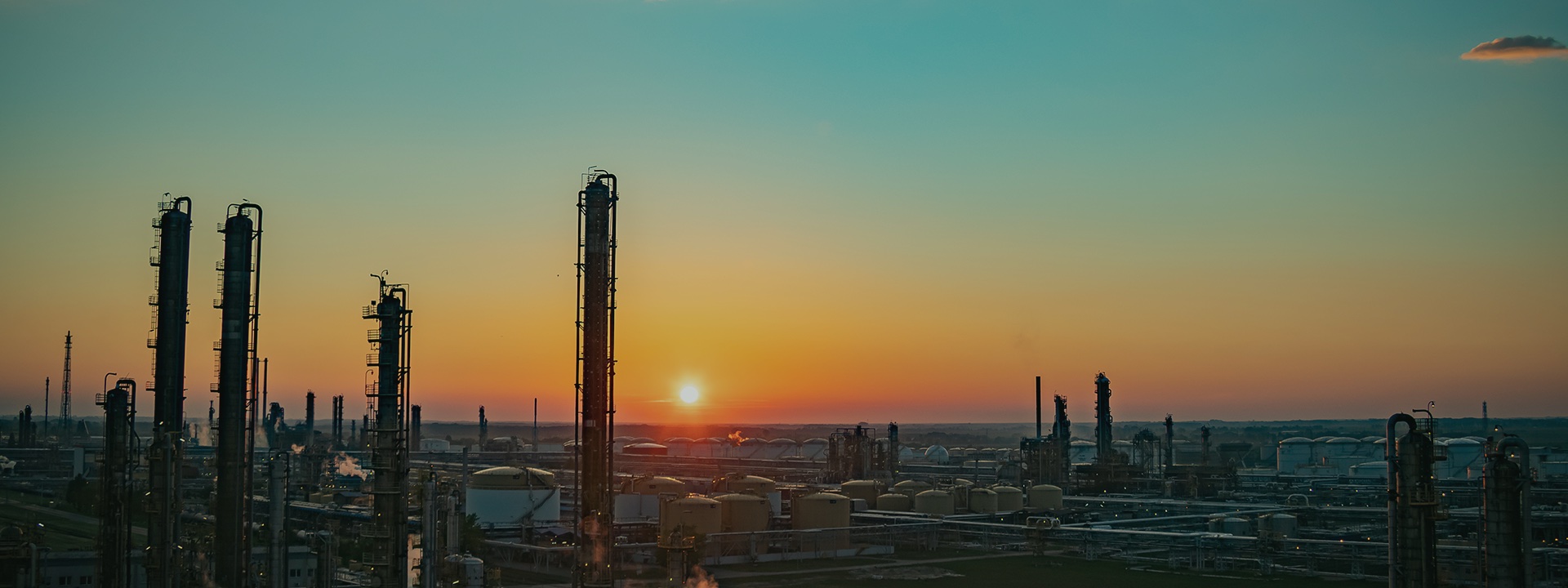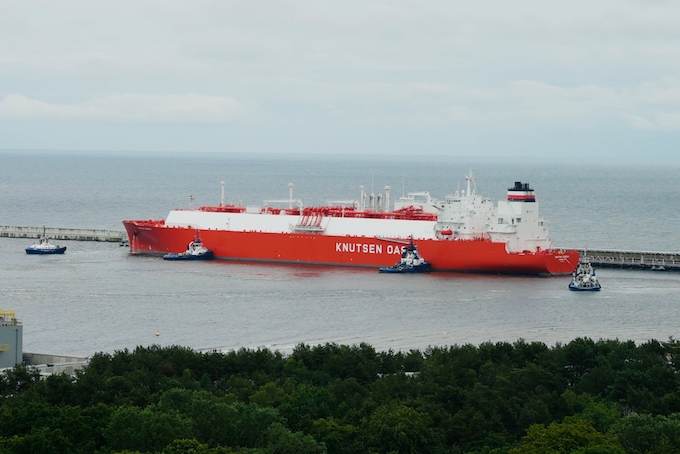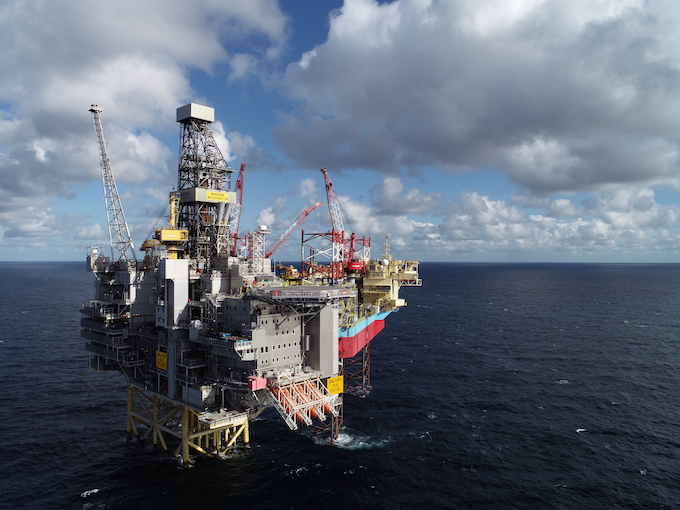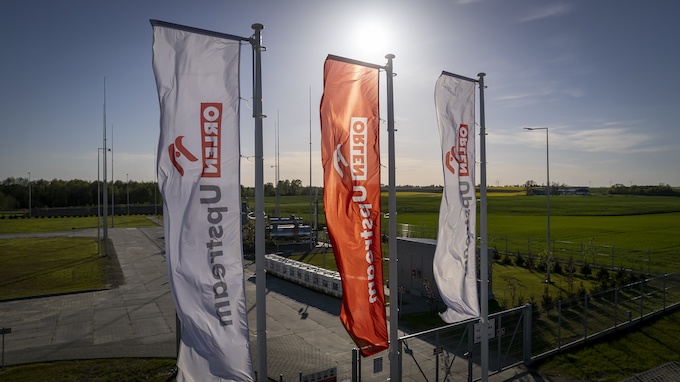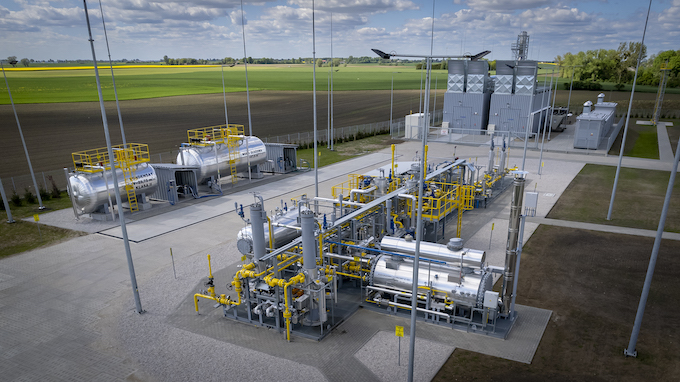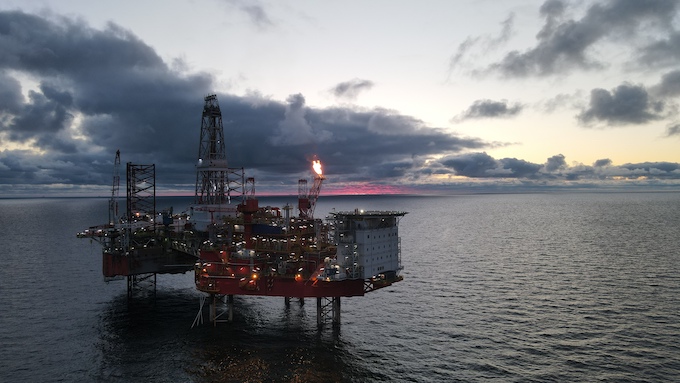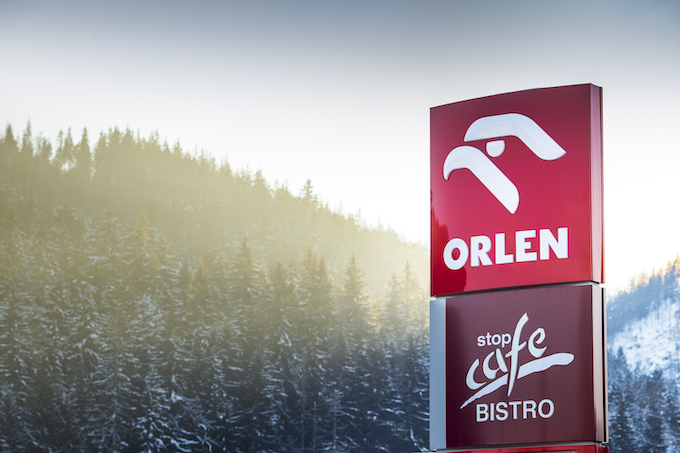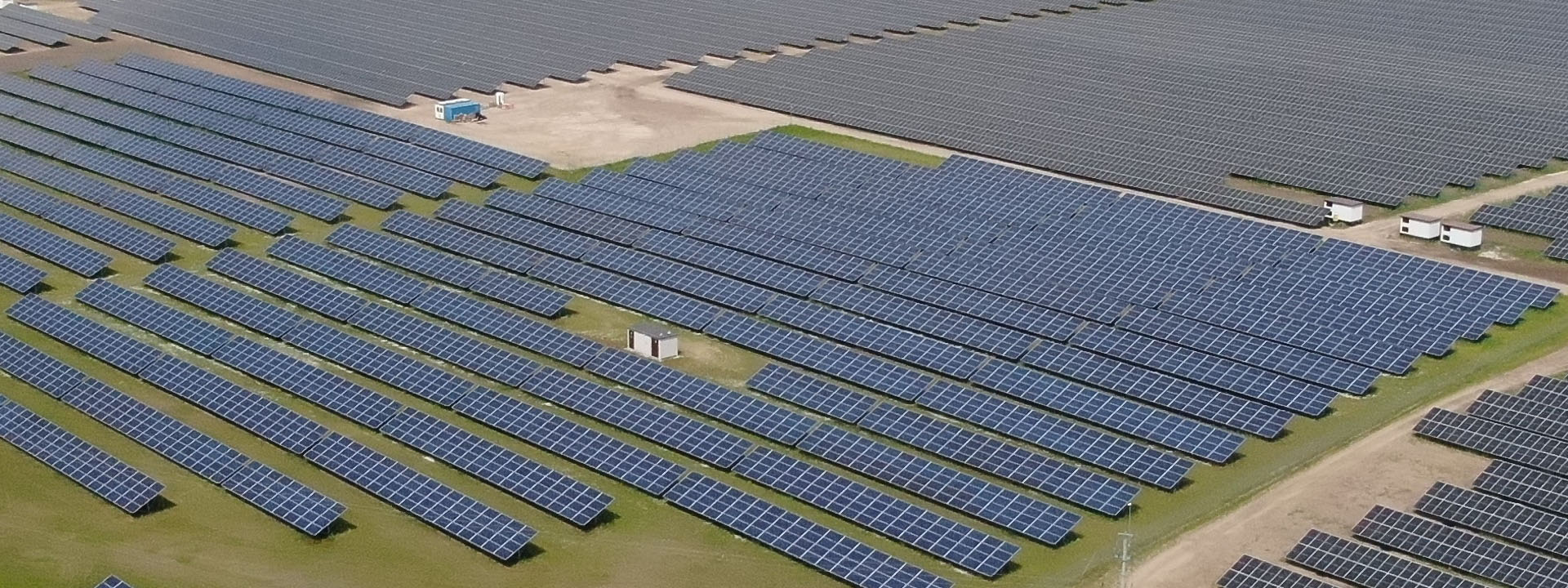Competitive environment
Upstream
2021 brought an economic rebound after the COVID-19 pandemic, leading to a surge in demand for energy commodities worldwide. The beginning of 2022 was marked by a significant imbalance of the energy system, which caused oil and gas prices to rise to levels that were advantageous for hydrocarbon producers during the first few weeks of the year. The full-scale energy crisis started at the end of February 2022, with Russia's military attack on Ukraine, sending hydrocarbon prices on a steep upward trajectory. In 2022, the average price of the Polish gas price index TGE DAwas approximately PLN 593/MWh (up by 164% relative to the average price in 2021, which was PLN 225/MWh). From the beginning of 2022, Europe struggled with major gas shortages on the market, resulting from the decline in volumes delivered from Russia that started back in 2021. After Russia's aggression against Ukraine, European countries began to fill their storage facilities to prepare for the possibility of a complete cut-off of supplies from the eastern direction. Gas prices soared globally, driven by a surge in demand and limited supply. In the first half of 2022, the average TGE DA price was PLN 474/MWh (up by 334% year on year, from PLN 109/MWh). In June 2022, gas transmission via Nord Stream was partly limited, and in July 2022 the pipeline was temporarily shut down. Growing concerns about Europe's ability to stock up sufficient gas volumes for the winter season spurred another significant price hike. In the third quarter of 2022, the average price of the TGE DA index reached a record high of PLN 952/MWh (up by 319% on the average price in the reference period, which was PLN 227/MWh). Amidst the looming gas and energy crisis in Europe, several European governments announced plans at the beginning of September to intervene in energy markets. Those measures, combined with a fast pace of filling gas storage facilities in the EU made possible by record high LNG supplies and favourable weather conditions, led to a considerable drop in gas prices. In the fourth quarter of 2022, the average price of TGE DA was PLN 466/MWh (up by a mere 4% relative to the reference period, when it stood at PLN 449/MWh).
1 Arithmetic mean of the TGEgasDA index as at the listing date.
In Canada, a supportive economic and the geopolitical climate, combined with high hydrocarbon prices globally, helped maintain favourable gas prices throughout the year. Greater local demand and a surge in gas exports to the US created a favourable pricing environment for the Canadian AECO gas price benchmark based on the prices at the AECO hub in Alberta. The average gas price in the first half of 2022 was CAD 6.0/mcf (up by 96% year on year, from CAD 3.1/mcf). Apart from global developments, another major driver of AECO prices in Q2 2022 was local factors related to the need to refill storage capacities after the winter season, with continued high temperatures, which generated increased gas consumption in the energy sector on an ongoing basis over the summer period. During the latter half of the year, the demand and supply situation showed some signs of stabilising due to reports of a potential economic downturn, notably in the United States, which is the primary importer of gas from Alberta.
In the second half of 2022, the average price of the AECO benchmark was CAD 4.6/MWh (up by 11% from the average price in the reference period, which was CAD 4.1/mcf). Overall, the average AECO price for the whole of 2022 was high, at CAD 5.3/mcf (an increase of 47% on 2021, when it was CAD 3.6/mcf). In the early weeks of 2022, crude oil prices were on the rise, driven by the continued excess of demand over supply, coupled with OPEC+’s cautious approach to restoring production levels. Following Russia's attack on Ukraine, the US and some Western European countries introduced an embargo on imports of Russian oil. As a result of insufficient supply of crude oil, global prices increased significantly, approaching the historical highs of 2011–2014. At the end of March 2022, news emerged regarding the release of a portion of strategic oil reserves by the United States and certain OECD countries. Additionally, new data suggested a possible decline in demand from South East Asia due to the next COVID-19 wave.
The average price of Canadian Light Sweet (CLS) in Q1 2022 was CAD 116/bbl (up by 74% year on year, from CAD 67/bbl).
The pressure on crude prices in Q2 2022 was exacerbated by low levels of gas stocks in storage in most western countries. The OPEC+ declaration, announced in early June 2022, to increase production by 200 thousand bbl/d in July and August (approximately 650 thousand bbl/d in total) failed to stabilise the market due to the limited impact of this measure in the global context. In Q2 2022, the average price of CLS crude was CAD 138/bbl (up by 79% year on year, from CAD 77/bbl). Despite the supply shortages, the market experienced negative sentiment generated by indications of a possible slowdown in the world's key economies due to the challenging macroeconomic situation, which led to a decline in oil prices. In response to these developments, OPEC+ decided in October to reduce production by 2 million bbl/d in an effort to support prices. The OPEC+ decision did not sit well with the US government, which announced, through the Department of Energy, the release of additional volumes of crude from the strategic oil reserves in November. Furthermore, in China, being the world's largest importer of crude oil, domestic demand fell considerably owing to the implementation of COVID-19 lockdowns. In addition, the strong US dollar reduced demand outside the US. In Q3 2022, CLS oil prices averaged CAD 117/bbl (up by 40% year on year, from CAD 84/bbl).
In Q4 2022, CLS oil prices averaged CAD 110/bbl (up by 18% year on year, from CAD 93/bbl). After a 'weaker' second half of the year, the average price of the CLS benchmark in 2022 was CAD 120/bbl (up by 50% on 2022, when it stood at CAD 80/bbl). In March 2022, BP published an updated BP Energy Outlook, a publicly available report that explores possible scenarios of global energy transition and its impact on selected macroeconomic variables. The three scenarios presented by BP: Net Zero, Accelerated and New Momentum, describe possible ways for the energy transition to unfold. The first two are broadly in line with the goals of the Paris Agreement and assume a significant reduction in carbon dioxide emissions. The Net Zero scenario additionally takes into account a lasting shift in societal behaviour and preferences, which accelerates the energy efficiency process and drives the uptake of low-carbon solutions in daily life. On the other hand, the New Momentum scenario places weight on the large number of decarbonisation initiatives and ambitions announced in recent years and the likelihood that those aims and ambitions will be achieved, and on the manner and speed of progress in their implementation.
The separate set of assumptions adopted for each scenario is designed to demonstrate the uncertainty associated with each of them and to present the outcomes of the energy system transformation for the respective transition paths. For each scenario, it was assumed that global energy consumption would grow in certain periods, Driven by increasing prosperity and improving living standards in the emerging world. The rate of growth in energy consumption and trends in demand for particular fuels continue to vary depending on the geography. Compared to the previous version of the report, i.e. Energy Outlook 2021, BP has revised the impact of the COVID-19 crisis on global GDP levels. Previous estimates predicting a GDP decline of 2.5% in 2025 and 3.5% in 2050 were updated (2025: GDP growth of 1%; 2050: long-term impact of the pandemic on the global GDP slightly lower than in the previous edition of the outlook). Despite persistent uncertainty, given the fairly wide roll-out of vaccination programmes and huge financial support to combating the virus, it can be assumed that the impact of the COVID-19 pandemic will be lesser than projected, at least in developed countries. According to BP's most recent projections, developed countries will be able to cut their energy demand in 2019–2050 by some 25–50% across all three scenarios. In emerging economies, a decline in energy consumption over the projection period is allowed for only in the Net Zero scenario, which puts it at some 10%. In the case of the other two scenarios, energy demand in developing countries will grow at a rate from 5% to 35%. The long-term trend shows progress in the decarbonisation of global energy demand as a result of increasing electrification and more widespread use of hydrogen.
According to projections to 2030, in each scenario the share of fossil fuels goes down by 3–6pp from the base level of 65% in 2019. Any significant differences between the individual scenarios in terms of trends and the pace of changes in the total share of fossil fuels will not be seen until mid-2030s. Ultimately, in 2050, the share of fossil fuels will be 20–50%, and the share of individual fossil fuels will depend on the adopted energy transition path. With 2019 set as the reference year, global demand for crude oil shows a downward trend, albeit with possible increases in the initial period. The scenarios differ significantly as regards the timing of peak demand for oil: oil consumption peaks in the mid-2020s in the Accelerated and Net Zero scenarios and at the beginning of 1930s in New Momentum. By 2050, global oil demand may decline at a rate from 20% to even 75%, mainly as a result of lower demand from the transport sector.
The fall in demand from road transport will be largely led by improving efficiency of the vehicles and increasing switch to electrification. In aviation and maritime transport, the decline in oil consumption will be driven by growing use of bio- and hydrogen-derived fuels. The decreasing use of oil in road transport accounts for around half of the fall in global oil consumption in the Accelerated and Net Zero scenarios and almost the entire fall in New Momentum. Reduced oil consumption will also be seen in other sectors of the economy, including industry and construction (Net Zero and Accelerated). Oil consumption becomes increasingly concentrated within emerging economies, and the use of oil as a feedstock in the petrochemicals sector is growing in importance. The global oil supply model is influenced by contrasting trends in oil production in the United States and in the OPEC countries. According to all three scenarios, in the near future US oil recovers after the drops in the first years of the projection. Non-conventional reserves and the short cycle nature of US oil production make it possible to increase oil supply relatively quickly. In order to maintain prices in the face of growing supply and falling demand, OPEC can only maintain production at current levels or implement cuts.
According to the projection, from the beginning of 2030s, in line with growing pace of decline in oil demand and deteriorating competitiveness of the US output, OPEC will take steps to increase production and gradually recover its market share. The long-term trends in global demand for natural gas differ between the energy transformation scenarios. The common element of all scenarios is an increase in demand in the initial part of the projection period. The growing demand for gas is driven by an increase in demand in emerging economies (continued industrialisation, mainly in China and India). Demand for gas peaks in mid 2020s, in the Net Zero scenario, or, with a slightly flattened curve, in 2025–2030 (Accelerated scenario). Developed countries (led by the US and the EU) will gradually reduce their consumption in industry and the energy sector (shift towards low-carbon energy sources), which will to some extent be offset by an increased use of gas for hydrogen production. In the New Momentum scenario, growing demand for gas in absolute terms is observed throughout the projection horizon, i.e. until 2050. In the period 2030–2040 this growth continues to be fuelled mainly by developing Asian countries and Africa. In the long term, to 2050, global demand for gas may even fall by 35–60% relative to 2019 (the Accelerated and Net Zero scenarios). In the New Momentum scenario, demand for gas is gradually growing throughout the BP's projection horizon (increase of 30% in 2019–2050).
Natural gas remains the key element of the global energy transition. Power generation and industry will continue to drive growth in natural gas demand in the medium term. In the longer term, the projected rise in demand will be caused by the use of gas for the production of blue hydrogen. The United States and developing economies, particularly Asian countries (China) and the Middle East remain the largest natural gas consumers. The United States, Russia and Middle East countries remain the largest gas producers. Following the merger of ORLEN with Grupa LOTOS and Polskie Górnictwo Naftowe i Gazownictwo, since 2022 the Upstream operations involving exploration for and production of mineral resources have been carried out through the ORLEN Upstream Group, LOTOS Upstream Group, LOTOS Petrobaltic Group, as well as companies and branches of the former PGNiG Group.
Operations in Poland
In accordance with the ORLEN Group's strategy, the exploration and production operations will be continued based on a conservative and sustainable development of the upstream asset portfolio, with a particular focus on gas fields. The capabilities and experience of the international team of ORLEN Group experts will actively support implementation of the ORLEN Group's mission and vision in upstream through efficient management of the diversified asset portfolio. Operators exploring for and appraising hydrocarbon deposits, and producing hydrocarbons from fields in Poland are mainly companies majority-owned by the Polish state.
The leader in this sector is the ORLEN Group, which, after the merger with the former LOTOS and PGNiG Groups:
- conducts exploration and appraisal work over an area of 53 licences (in the case of 6 of them investment decisions have been issued, which are the basis for starting the production phase), accounting for 80% of all licences for exploration for and appraisal of crude oil and natural gas deposits issued in Poland as at the end of 2022;
- holds a total of 185 licences for oil and gas production, or more than 98% of all licences issued for the production of hydrocarbons from deposits in Poland as at the end of 2022.
The companies of the former LOTOS Group are leaders in exploration and production within the Polish zone of the Baltic Sea. All three combined licences for offshore hydrocarbon exploration, appraisal and production in the Łeba, Rozewie and Gotland areas, and all four licences for hydrocarbon production from the B3, B8, B4 and B6 oil and gas fields in the Polish Economic Zone of the Baltic Sea have been issued to subsidiaries of the former LOTOS Group and their joint ventures.
Companies holding hydrocarbon exploration and appraisal licences and hydrocarbon production licences as at December 31st 2022
Operations in Canada
In the province of Alberta, Canada, the ORLEN Group is a recognised operator with exploration and production assets totaling about 352.8 thousand gross acres (about 1.4 thousand km2), and in terms of number of shares about 231.1 thousand net acres (about 0.9 thousand km2) and total 2P resources of 158.0 million boe.
Operations in Norway
Exploration and production activities on the Norwegian Continental Shelf remained very strong in 2022. The average hydrocarbon output was close to 4 mboe/day, up by 0.4% relative to 2021. In addition, 13 Plans for Development and Operation (PDO) of new fields with a total value of NOK 229 billion were prepared and submitted for approval, which will have a positive effect on the project activities in the coming years. The ongoing war in Ukraine and the related energy crisis had a material impact on production activities in Norway in 2022. Measures were taken to secure stable energy supplies to Europe in the long term. In particular, at the end of 2022, Norway became the largest supplier of natural gas to Europe.
The following key statistics present a picture of the market environment in Norway for 2022:
- 3.99 mboe/day of average hydrocarbon production (up by 0.4% year on year);
- NOK 172.2 billion of realised investments, including exploration costs (down by 7.4% year on year),
- 93 fields in the production phase;
- 13 Plans for Development and Operation submitted for approval, including for the Yggdrasil (formerly NOAKA) and Trell/Trine fields in which LOTOS Norge holds interests;
- 32 exploration wells drilled;
- 11 new discoveries;
- 53 new licences awarded under the APA 2021 round.
In 2022, hydrocarbon production in Norway averaged 3.99 mboe/day, up by 0.4% year on year. Slightly more than half of the production volume, i.e. 53%, was made up of liquid fractions, including: crude oil, condensate and NGL (natural gas liquids). The share of natural gas in the production volume was 47%. The Norwegian Petroleum Directorate, a governmental administrative body, assumes a stable high level of hydrocarbon production from the Norwegian Shelf over the next five years. The projected average production volume is approximately 4.17 mboe/day in 2023–2027, with the highest level expected in 2025 (some 4.30 mboe/day).
Historical and planned hydrocarbon output levels on the Norwegian Continental Shelf (mboe/day).
Source: In-house analysis based on publications and data from the Norwegian Petroleum Directorate https://www.npd.no/en/facts/publications/reports/the-shelf/the-shelf-in-2022/
2022 saw stable and intense investment activity of exploration and production companies on the Norwegian Continental Shelf. Investment, taking into account exploration costs, totalled NOK 172.2 billion (down by 7.4% year on year). As part of the activities, 13 Plans for Development and Operation with a total value of NOK 229 billion were submitted for approval, 32 exploration wells were drilled, and 11 new oil and gas fields were discovered. The Norwegian Petroleum Directorate assumes a stable level of activity over next five years, with average investment, taking into account exploration costs, projected at approximately NOK 194 billion annually in 2023–2027.
Historical and planned investment levels on the Norwegian Continental Shelf (NOK billion).
Source: In-house analysis based on publications and data from the Norwegian Petroleum Directorate https://www.npd.no/en/facts/publications/reports/the-shelf/the-shelf-in-2022/
Despite the high production volumes and large investments in the development of new fields, there was a drop in greenhouse gas emissions associated with production activities on the Norwegian Continental Shelf. The target is to reduce CO2 emissions by half by 2030 relative to 2005.
The Norwegian Continental Shelf continues to offer attractive potential resources. According to the estimates of the Norwegian Petroleum Directorate, the total potential resources of the Norwegian Continental Shelf are approximately 15,864 mcm of oil equivalent, of which nearly half has been produced from the fields. A half of the resources, i.e. approximately 8 bcm of oil equivalent, may still be produced. This includes both proved reserves in producing fields and fields under development (ca. 2.7 bcm in aggregate), contingent resources in new discoveries (ca. 1.4 bcm), as well as undiscovered prospective resources identified in exploration licence areas (ca. 3.8 bcm, or 24% of total potential resources).
As at the end of 2022, 39 exploration and production companies were active on the Norwegian Continental Shelf, including: 18 companies as a licence operator, and 21 companies as a non-operator . In recent years, the number of active market players has declined due to the ongoing asset consolidation processes (from the record-high number of 56 companies active in 2013). The Norwegian Continental Shelf remains an attractive area for E&P companies, which is due to such factors as the high resource prospectivity, still high potential for new oil and gas discoveries, positive trends in cost reduction, efficiency improvement and development of new technologies, active market, as well as stable fiscal and regulatory environment.
Reserve potential of the Norwegian Continental Shelf (bcm).
Source: In-house analysis based on publications and data from the Norwegian Petroleum Directorate https://www.npd.no/en/facts/publications/reports/resource-report/resource-report-2022/
Operations in Lithuania
There is no active E&P market in Lithuania. The former LOTOS Group companies forming part of the AB LOTOS Geonafta Group are the only entities engaged in production of oil from Lithuanian fields. The Lithuanian companies are wholly owned by AB LOTOS Geonafta, except for UAB Minijos Nafta, in which AB LOTOS Geonafta holds 50% of shares, and the other shareholders are Tethys Oil AB, Odin Energy A/S and private investors.
Refining
In 2022, there was a noticeable trend of refineries worldwide rebuilding capacity utilisation, driven by favourable price conditions (high crack spreads on products). In this context, many plants expanded their capacities to address the product shortfall that occurred after the decrease in supplies from Russia, even though sanctions on imports from Russia entered into force in 2023. Refineries’ operations in recent years were mainly driven by three key variables. First, the COVID-19 pandemic led to a temporary decline in fuel demand, Affecting the refineries’ ability to place their products on the market, and depressing the margins. Numerous plants worldwide were closed down, resulting in a total capacity loss of at least 3.8 million bbl/day. Furthermore, a number of investment projects in the Middle East, Asia Pacific, and Africa were not completed as scheduled due to the pandemic. Consequently, the increase in processing capacities for 2022 was relatively low.
The second factor was the modification of China's export policy for fuel products. Since 2021, the number of fuel export licences issued to oil companies (mainly for gasoline, diesel oil and aviation fuel) has been falling, limiting the supply of those products on international markets. Third, Russia’s aggression against Ukraine affected the availability of not only Russian crude, but mostly of products manufactured in this country (Russia was one of the key suppliers of diesel oil to the European market). The sanctions reduced the availability of diesel oil on the market. On the other hand, imports of this product from such regions as the Middle East and Asia Pacific generate additional costs and increase its price on international markets.
Against this backdrop, margins capacity utilisation rates kept rising globally throughout 2022. Since 2012, a number of refineries, with a total capacity of approximately 2 million bbl/day, have been closed down across Europe. There are more than 100 refineries in Europe with different conversion levels, and some of them (taking into account the prevailing market conditions) have low profitability, as a result of which a number of the plants have already been or will be closed down shortly. A visible trend in the current conditions is also the conversion of plants biorefineries. This process may be slowed down by the current high levels of crack margins, but in the long term it is complex refineries that will enjoy the greatest profits, and thus a competitive edge, rather than simple plants capable of adapting quickly to market conditions.
Crude oil processing worldwide (million bbl/day)
Source: In-house analysis based on OPEC data.
The largest competitors of the ORLEN Group in the refining market are:
- The Mitteldeutschland refinery in Leuna/Spergau in south-eastern Germany, Germany's most modern refinery.
- The PCK refinery in Schwedt is located northeast of Berlin, close to the Polish-German border.
-
Bayernoil refinery, headquartered in Neustadt an der Donau in Bavaria.
- MiRO refinery, being one of the largest refineries in Germany and one of the most advanced refineries in Europe, located in Karlsruhe in Baden-Württemberg;
- Ruhr Oel refinery, one of the largest German refineries, with integrated petrochemical operations, located in Gelsenkirchen in the Ruhr;
- Holborn Europa Raffinerie, located in Hamburg in northern Germany;
- Schwechat refinery in Austria, located near Vienna.
- Slovnaft refinery, an integrated refining and petrochemical group, with a leading position in the Slovak Republic, located near Bratislava;
- The Danube Refinery, being one of the largest refineries in the CEE region, owned by MOL, located in Százhalombatta, Hungary;
- Mozyr refinery, a leading refinery in Belarus, located close to the Ukrainian border.
Petrochemicals
The largest competitors of the ORLEN Group in the petrochemical market are:
- Ineos Olefins & Polymers Europe, with annual production capacities of about 2,190 thousand tonnes of polyethylene (HPDE, LDPE, LLDPE), about 750 thousand tonnes of polypropylene, and about 120 thousand tonnes of MPG; assets located in Belgium, France, Germany, Italy, Norway and the UK.
- Sabic – annual capacities of about 1,850 thousand tonne of polyethylene (HPDE, LDPE, LLDPE), and 1,100 thousand tonnes of polypropylene; assets located in Germany, the Netherlands and the UK.
- Lyondell Basell Industries – the largest manufacturer of polyethylene (HDPE, LDPE) with annual production capacities of about 2,000 thousand tonnes, about 2,400 thousand tonnes of polypropylene, about 160 thousand tonnes of MPG, and assets located in Germany, France, the Netherlands.
- Borealis with annual production capacities of about 1,970 thousand tonnes of polypropylene, and about 1,770 thousand tonnes of polyethylene (LDPE, LLDPE, HDPE), and assets located in Belgium, Germany, Austria and Finland.
- Total Petrochemicals – annual production capacities of about 1,220 thousand tonnes of polypropylene, about 1,060 thousand tonnes of polyethylene (HDPE, LDPE, LLDPE), with assets located in Belgium and France.
- Indorama – Europe’s largest PTA manufacturer, with a nominal production capacity of 1,750 thousand tonnes per year and assets in Portugal, Spain and the Netherlands;
- Inovyn – a company formed following the combination of Ineos Chlor and Solvay; its annual production capacity is 2,000 thousand tonnes of PVC.
- Dow Deutschland has a an annual production capacity of about 290 thousand tonnes of MPG, and assets located in Germany.
Gas
The global energy commodity markets saw significant changes during 2022. The outbreak of the Russian-Ukrainian conflict led to a significant rise in the prices of most hydrocarbons in the global markets. The war disrupted the natural mechanisms of price formation, resulting in significant price volatility. A combination of factors resulted in significant fluctuations in price levels, including political statements, speculation, and sanctions. Gazprom's actions, which involved breaching existing contracts and disrupting gas supplies to Poland and Bulgaria, further compounded the issue. Consequently, in 2022, the European Union countries opted to reduce their import volume of gas from Russia and instead rely on imported LNG from the US. This decision prompted changes to the natural gas balancing system and underscored the significance of sources and infrastructure related to LNG imports.
Imports of natural gas to Poland in 2016–2022 (TWh)
In response to these developments, the ORLEN Group took measures to secure long-term regasification and transmission capacities. These steps were taken to meet the demand for natural gas and LNG on the Polish wholesale market, as well as to expand the Group's sales activity in the CEE markets. In 2022, in order to secure sources of natural gas, the ORLEN Group imported gas to Poland based on a diversified portfolio of contracts. The ORLEN Group has also increased its activity on the Norwegian Continental Shelf (NSK) and the Danish Continental Shelf (DSK) to prepare for the start of gas deliveries to Poland via the Baltic Pipe. This move is expected to facilitate the supply of natural gas from these fields to Poland. As part of its operations on the NCS, the Group also started to procure and sell natural gas liquids (including propane, butane, paraffin and ethane).
To increase the volume of imported LNG, the ORLEN Group focused on developing both FOB (Free on Board) and DES (Delivery Ex Ship) deliveries through spot market transactions and medium-term contracts. This approach bore fruit in May 2022, when the first LNG FOB cargo from the US arrived at the Port of Świnoujscie aboard the Maran Gas Apollonia. Throughout the year, a total of 12 FOB LNG shipments from the US to Poland were made. The ORLEN Group is expanding its commercial and logistics competencies related to LNG, which will facilitate further trade development and the optimization of long-term contracts from 2023. To meet the demands of its long-term FOB supply contracts, the ORLEN Group signed new LNG transport agreements. As of the end of 2022, the Group's transport fleet included four LNG carriers with capacities ranging from 160 to 174 thousand m3.
The ORLEN Group is actively expanding its business into markets that are expected to become strategically important for the Polish market due to emerging gas infrastructure. These include Slovakia, Ukraine, and Lithuania, as well as indirectly relevant markets like Italy, Hungary, Latvia, and Estonia. Building capabilities and strengthening presence in the region will enable the company to gain an additional market for gas from the northern direction and optimise its gas portfolio potentially using, among other things, the storage systems in Poland, Latvia, Ukraine and Slovakia.
To achieve this objective, the ORLEN Group reserved regasification capacity at the Klaipeda LNG Terminal and commenced deliveries from this source on May 1st 2022. Simultaneously, the ORLEN Group commenced trading on the GET Baltic exchange and started sales to wholesale customers in Lithuania and Estonia.
Retail
The retail market in Poland faced various challenges in 2022, including regulatory changes at the global, national, and industry level, which imposed new reporting, settlement, and operational requirements on organisations operating in the market, including the ORLEN Group.
In response to the 2022 crisis in the European energy market, the Polish government enacted laws to support gas and energy market users in the country, with a focus on minimizing the impact of gas and electricity price increases on the most vulnerable consumers. To adjust to the legislative changes, the ORLEN Group prioritized efforts to safeguard its key customer groups from the adverse effects of price increases and inflationary pressures.
By doing so, the company aims to maintain a stable customer base and remain competitive in the retail market over the long term.
In 2022, the ORLEN Group had to confront and adapt to the challenges posed by:
- a dramatic increase in the volatility of natural gas prices. This had a direct impact on the Group's financial performance due to changes in tariff and special market protection rules, as well as fluctuations in gas fuel prices that affected customer purchasing and investment decisions. Additionally, the situation posed threats to the Group's image and communication efforts, such as the effectiveness of initiatives aimed at promoting gas fuel and improving air quality;
- the progressing energy transition, driven by climate policy initiatives at the European Union level and market expectations. This presented various competitive, technological, and investment challenges for the company;
- the risk of substitution of gas fuel by customers in tariff groups 1 to 4 with alternative solutions;
- the risk of substitution of solutions based on natural gas.
At the same time, changes in the ORLEN Group's environment create a number of opportunities, including:
-
expanding the product and development potential of the multi-utility group, following the merger between PGNiG and ORLEN;
- the role of natural gas as a transition fuel for the coming decades, in connection with the 2050 climate neutrality policy goals and objectives, as well as its inclusion in the EU taxonomy;
- leveraging industrial and power projects in Poland to ramp up gas sales;
- further leveraging the sales potential of the current B2C customer base by introducing additional add-on products;
- digitalization and leveraging the potential of existing sales and customer service channels – developing multi-channel services based on a nationwide network of customer service offices, with an increasing role for electronic customer service channels, including mobile applications;
- growing demand from B2B customers for advanced gas products (including LNG) and electricity as well as related services and products, including consultancy and other solutions enabling cost optimisation;
- expanding the offering of hybrid solutions and new models to meet energy needs, also using RES solutions, in response to evolving customer expectations and project co-financing options;
- development of fuel demand for low-emission land and marine transport;
- steps taken by local governments to reduce low-stack emissions and growing awareness of potential customers in this respect, planned and existing programmes and mechanisms to co-finance smog prevention.
The ORLEN Group's main and most active competitors on the retail gas market are: Fortum, Axpo, Enea, Veolia and Tauron. Within the LNG retail market, the main competitors are: DUON Dystrybucja, sp. z o.o, CRYOGAS M&T POLAND S.A., BARTER sp. z o.o., Shell Polska Sp. z o.o. oraz Gaspol S.A. W przypadku obszaru bunkrowania LNG największą aktywność konkurencyjną wykazuje DUON Dystrybucja sp. z o.o., Barter S.A., Cryogas sp. z o.o., Gascom sp. z o.o. oraz podmioty zagraniczne, m.in. Nauticor oraz Gasum.
Gas distribution
The dynamic changes in the energy and gas fuel market, as well as changes in legal regulations, described in Section 4.3 of the Report, prompted Polska Spółka Gazownictwa (PSG), a part of the ORLEN Group that operates in the gas distribution area, to initiate strategic analyses that focus on:
- Fulfillment of PSG's primary responsibilities as a Distribution System Operator (DSO), which include ensuring the safe and uninterrupted supply of gas to end users, as well as operating, maintaining, and expanding the distribution network;
- Identification of necessary changes in the national tariff and regulatory environment aimed at stabilizing the situation in the Polish gas fuel market;
- Maintaining cost discipline;
- Acquiring an effective distribution volume;
- Integrating alternative fuels (hydrogen, biomethane) into the business model;
- Continued work on optimizing internal processes and further implementation of digital transition projects. So far, PSG has followed an expansion-oriented strategy focused primarily on increasing gasification efforts in new municipalities and connecting new customers. In 2022, PSG faced competition from 49 other entities, including 17 DSOs and 32 non-DSOs, operating in 154 municipalities.
Operating areas of competitors in Poland.
Source: In-house analysis based on PSG data.
Number of municipalities where competitors operate.
*UNIMOT System Sp. z o.o. and Blue LNG Sp. z o.o.
** Other DSOs operating in two or fewer municipalities.
NOVATEK GREEN ENERGY – network operated by PSG
The measures were taken in response to the market demand for gas network connections and the government's efforts to improve air quality in Poland. However, based on conducted market analysis, it is expected that the number of new service lines will stabilize in the coming years and the focus will shift towards densifying the distribution network. The medium-term strategy for PSG includes expanding its customer base in the utility power sector, with an emphasis on district heating below 50 MW. This aligns with the company's Energy Transition Programme that was launched in 2021. This is also consistent with the provisions of the Medium Combustion Plant (MCP) Directive, which enforces stricter emission standards for certain pollutants from medium-sized combustion sources into the air. Existing installations larger than 5 MW have until January 1st 2025 to comply with the new emission standards, and those up to 5 MW until January 1st 2030.
According to strategic analyses, transitioning to gaseous fuel is seen as an opportunity for these facilities to reduce harmful emissions. Several factors, including legal and market conditions determined by the EU climate and energy policy (such as the European Green Deal and Fit for 55), are expected to bring about changes in energy production and consumption in the domestic energy sector and the energy market in the long term. The Energy Policy of Poland until 2040 provides insights into the development directions of the sector. In the face of decarbonization and climate policies, the gas sector is challenged by alternative fuels, such as electricity (heat pumps), LPG, and system heat generated from fuels other than gas, among others, which may compete as substitutes in meeting the energy needs of end users.
Nonetheless, the Green Deal initiative presents opportunities for the gas sector to transform its grid to distribute renewable gaseous fuels, including biomethane, hydrogen, and synthetic natural gas. PSG, as the leading gas fuel distributor in Poland, has been investigating the technical and regulatory requirements of integrating renewable gases, such as biomethane, hydrogen, and synthetic natural gas, into its gas infrastructure since 2014.
Retail
According to the ‘Energy Transition Investment Trends’ report published by BloombergNEF in January 2023, electrification of transport (which also includes hydrogen vehicles and infrastructure) is the fastest growing (in absolute terms) category among energy transition projects. The Group's strategy is to develop and increase production in all technologies to decarbonize this sector, which accounts for about one-fifth of global CO2 emissions.
Passenger transport has seen significant increase in electric car sales, with electric cars and plug-in hybrids accounting for more than 30% of cars sold in Europe in the fourth quarter. The electric car fleet is growing fastest in Western Europe, but countries such as the Czech Republic and Poland are also seeing dynamic growth. In the strategy update, we are responding to the accelerating pace of transport electrification – by 2030, the ORLEN Group will increase the number of charging points from about 600 to more than 10,000. The transformation of trucking and long-distance passenger transport presents a greater technological challenge, as the path to decarbonization is still unclear, with hydrogen and battery-based solutions competing for dominance. Regarding the former, the ORLEN Group plans to begin producing renewable hydrogen, aiming to produce no less than 130 kt by 2030.
The market trends in 2022 were significantly affected by the geopolitical and macroeconomic situation. The ongoing armed conflict in Ukraine and rising inflation have slowed down the pace of economic recovery following the COVID-19 pandemic and related restrictions. These factors have had a significant impact on the market. InPoland, 2022 was a period of recovery in volumes of fuel and non- fuel sales. The sales growth was positively impacted by the relaxation of restrictions and limitations associated with the COVID-19 pandemic, which resulted in an increase in vehicle traffic and the resumption of food service operations at gas stations. Volume sales were also significantly affected by Russia's invasion of Ukraine in February 2022, which contributed to a temporary, but sharp, increase in fuel demand. The demand normalized in the second half of the year. In 2022, the successful completion of the merger between ORLEN and Grupa LOTOS led to a significant transformation in the ownership structure of fuel stations operating across Poland. Subsequent to the merger, ORLEN effectively expanded its network by incorporating an additional 90 LOTOS service stations into its operations.
In Germany, 2022 was highly unpredictable. The conflict in Ukraine, coupled with the related measures implemented by the German government, gave rise to concerns surrounding the security of supply. Consequently, this led to considerable fluctuations in commodity prices on international markets. Due to high gas prices, industrial companies were forced to partially replace the gas with fuel oil to meet their energy needs. Due to the energy tax cut in early June and late September 2022, there were temporary supply shortages at gas stations. The challenging supply situation was further aggravated by the persistently low water levels on the Rhine, which adversely impacted barge deliveries. Although significant delays were encountered, rail transport remained stable for the most part in 2022. At the beginning of 2022, the COVID-19 restrictions in the Czech Republic and Slovakia continued to adversely impact traffic at service stations. The war in Ukraine, which is one of the factors driving prices in the market, contributed to a loss of volume to low-priced competitors such as Tank ONO and EuroOil.
In 2022, in Hungary the government introduced a 20-liter per transaction limit at gas stations in response to the consequences of the Russian- Ukrainian conflict. The decision led to a significant drop in sales. In order to counteract the negative effects of the government’s decision, the ORLEN Group implemented measures to increase fuel sales, including the introduction of a discount of 10 HUF per litre in the ORLEN HU app for all registered customers who fill up a minimum of 20 litres. In 2022, the Lithuanian fuel market was significantly impacted by the reduction of VAT on fuel in Poland and the increase in selling prices due to the war in Ukraine. Throughout 2022, sales of diesel oil on the retail market fell 8% (y/y), while sales of gasoline and LPG rose by approximately 4% (y/y). In the absence of any acquisitions or ownership changes involving the primary participants in the retail fuel market, the leading chains maintained their respective market positions within the ORLEN Group's other operating markets. The ORLEN Group is the undisputed leader in retail fuel sales in Central Europe. At the end of 2022, the ORLEN Group had a total of 3,097 stations, which included 90 stations that were acquired as part of the merger with Grupa LOTOS Group. The ORLEN Group had 820 operational RUCH retail outlets at the end of 2022.
In 2022, the ORLEN Paczka service continued to expand, replacing the previous' Traffic Paczka 'service. Following the change, e-commerce customers were offered a larger number of pickup points: parcel lockers (1,847), and, as before, Ruch kiosks and partner outlets.
In the coming years, the ORLEN Group intends to further expand the geographical coverage of the ‘Orlen Parcel’ service. In order to increase the capacity and efficiency of the ‘Orlen Paczka’ logistics network, a new sorter and central sorting facility were launched in Stryków.
In Poland, our service stations operate under the ORLEN brand in the premium segment and under the Bliska brand in the economy segment (with the share of the economy segment gradually declining year on year). In the Czech Republic, they are branded as Benzina or Benzina ORLEN, while in Slovakia and Lithuania − as ORLEN. On the German market, ORLEN Deutschland operates economy stations under the umbrella brand STAR ORLEN and the network is complemented by more than a dozen Familia supermarket stations. As of December 2022, the ORLEN Group owns 79 service stations in Hungary under the ORLEN brand.
Energy
In the Energy segment, the largest competitors of the ORLEN Group are:
- PGE Polska Grupa Energetyczna S.A. Group, which is Poland’s largest vertically integrated producer of electricity and heat. With its own sources of raw materials, electricity generation facilities and distribution network, the PGE Group guarantees deliveries of approximately 41 TWh of electricity annually to over 5.4 million households, businesses and institutions.
- TAURON Polska Energia Group – consisting of TAURON Polska Energia S.A. of Katowice and its subsidiaries. Supplying around 52 TWh of electricity annually to over 5.6 million end customers, the TAURON Group it the largest electricity distributor in Poland, the second largest electricity seller in Poland, and the largest heat supplier in Upper Silesia. The Group controls roughly 30% of Poland's thermal coal reserves.
- Enea Group – the second largest power producer in the Polish electricity market. It manages the full value chain in the electricity market: from fuel, through to power generation, distribution, sales and customer service. The Group is responsible for reliable supplies of energy to 2.6 million customers. Enea Operator owns a distribution network in north-western Poland (spanning approximately one-fifth of Poland's area). The Enea Group employs over 17 thousand people across Poland, who form a modern energy company. The Enea Group operates two important commercial power plants, in Kozienice and Połaniec. It also includes the Lubelski Węgiel Bogdanka mine, which is the main supplier of coal for the Group's power plants. Another area of Enea Group’s operations is generation of heat at its plants in Białystok, Oborniki and Piła.
Read also:
Short-cuts:
ORLEN Group 2022 Integrated Report
You can also download the report in PDF format
